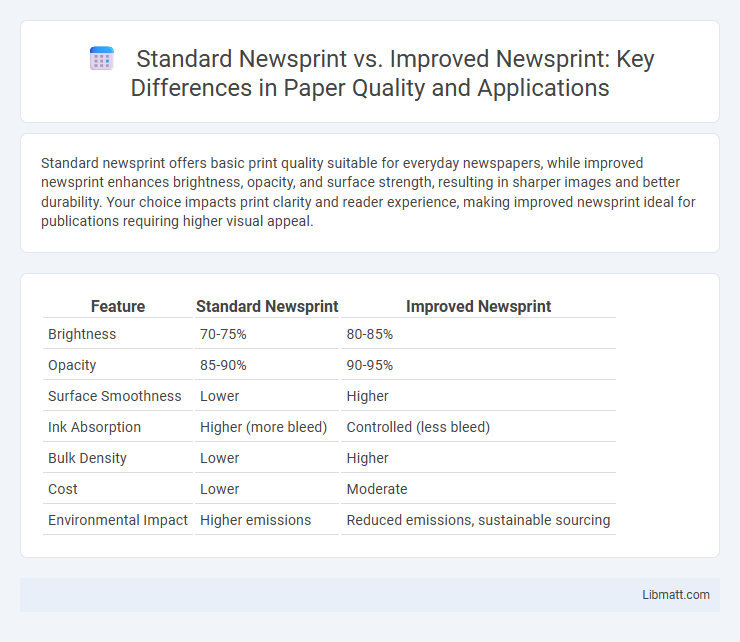Standard newsprint offers basic print quality suitable for everyday newspapers, while improved newsprint enhances brightness, opacity, and surface strength, resulting in sharper images and better durability. Your choice impacts print clarity and reader experience, making improved newsprint ideal for publications requiring higher visual appeal.
Table of Comparison
| Feature | Standard Newsprint | Improved Newsprint |
|---|---|---|
| Brightness | 70-75% | 80-85% |
| Opacity | 85-90% | 90-95% |
| Surface Smoothness | Lower | Higher |
| Ink Absorption | Higher (more bleed) | Controlled (less bleed) |
| Bulk Density | Lower | Higher |
| Cost | Lower | Moderate |
| Environmental Impact | Higher emissions | Reduced emissions, sustainable sourcing |
Introduction to Newsprint Types
Standard newsprint is a low-cost, lightweight paper made primarily from mechanical pulp, widely used for mass-market newspapers due to its high opacity and good ink absorption. Improved newsprint incorporates higher-quality fibers, often blending recycled and stronger virgin pulp, enhancing durability, brightness, and print clarity. These advancements lead to better print resolution, reduced ink bleed, and increased resistance to yellowing, making improved newsprint ideal for premium publications.
What is Standard Newsprint?
Standard newsprint is a low-cost, lightweight paper primarily made from wood pulp used in daily newspapers and other mass publications. It features a high absorbency rate and lower brightness compared to improved newsprint, resulting in reduced image sharpness and color vibrancy. This basic newsprint type is designed for short-term use and easy recyclability, optimizing cost efficiency over durability.
Defining Improved Newsprint
Improved newsprint is engineered to enhance print quality and durability compared to standard newsprint by incorporating better fiber composition and advanced coating techniques. This results in sharper text, richer color reproduction, and greater resistance to smudging and moisture, making it ideal for high-quality newspaper production. Your publications will benefit from increased reader satisfaction and reduced print errors when opting for improved newsprint.
Raw Materials and Manufacturing Differences
Standard newsprint primarily uses lower-grade mechanical pulp derived from softwood trees, resulting in higher lignin content and shorter fiber length, whereas improved newsprint incorporates a blend of higher-quality chemical pulps and recycled fibers to enhance paper strength and printability. The manufacturing process for improved newsprint includes advanced refining and deinking technologies that reduce impurities and increase brightness, contrasting with the more basic production methods of standard newsprint. These differences in raw materials and manufacturing lead to improved newsprint exhibiting better opacity, runnability on printing presses, and overall durability.
Optical Properties: Brightness and Opacity
Improved newsprint offers higher brightness levels, enhancing the clarity and vibrancy of printed images compared to standard newsprint. Opacity is also significantly better in improved newsprint, reducing show-through and improving readability, especially for double-sided printing. Your choice of newsprint directly impacts the visual quality and legibility of newspapers and flyers.
Printability and Ink Absorption
Improved newsprint offers enhanced printability through finer fiber composition and more uniform surface texture, resulting in sharper images and clearer text compared to standard newsprint. Ink absorption in improved newsprint is optimized to reduce ink spread and smudging, providing better color fidelity and faster drying times for high-quality print results. Choosing improved newsprint elevates the overall visual appeal and readability of your printed materials.
Cost Comparison: Standard vs Improved
Standard newsprint typically costs less upfront due to lower-quality fibers and simpler production processes, making it a budget-friendly choice for bulk printing. Improved newsprint, while more expensive initially, offers enhanced durability, better print clarity, and reduced paper dust, resulting in lower long-term costs through decreased waste and fewer printing issues. Your investment in improved newsprint can lead to overall savings by minimizing maintenance and improving the quality of your printed materials.
Environmental Impact and Sustainability
Standard newsprint typically relies on virgin wood fiber, contributing to deforestation and higher carbon emissions, whereas improved newsprint increasingly incorporates recycled content, reducing waste and conserving natural resources. Improved newsprint's lower energy and water consumption further enhance its sustainability profile, promoting a smaller ecological footprint throughout production and disposal. You can support environmental responsibility by choosing improved newsprint options that align with sustainable forestry certifications and recycling initiatives.
Common Applications in Publishing
Standard newsprint is widely used for daily newspapers, community bulletins, and flyer printing due to its cost-effectiveness and adequate print quality. Improved newsprint, featuring enhanced brightness, opacity, and smoother texture, is favored for high-quality magazines, promotional materials, and special editions where image clarity and color reproduction are critical. Your choice between these papers impacts the visual appeal and durability of published content, influencing reader engagement and brand perception.
Choosing the Right Newsprint for Your Needs
Standard newsprint offers a cost-effective option with acceptable print quality, primarily used for high-volume distribution where budget constraints are critical. Improved newsprint enhances brightness, opacity, and surface smoothness, resulting in sharper images and more vibrant colors suited for publications aiming to attract discerning readers. Evaluating your publication's target audience and visual impact goals helps determine if the investment in improved newsprint aligns with your branding and engagement objectives.
Standard newsprint vs improved newsprint Infographic

 libmatt.com
libmatt.com